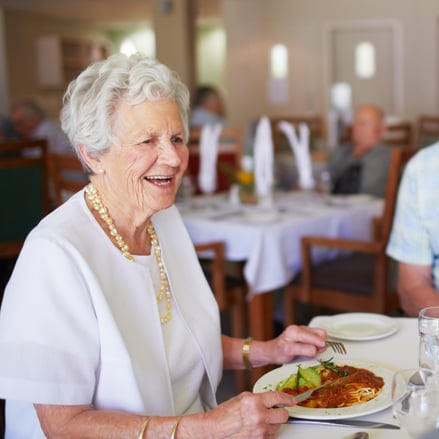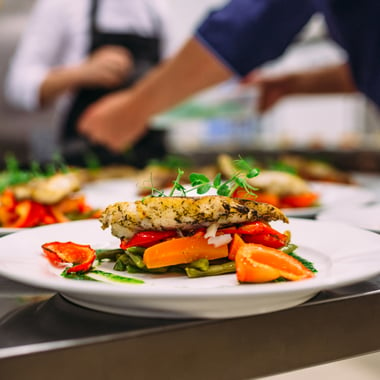Nostalgia in the Kitchen: Feeding the Memory
Jeff Wuollet, Executive Director or Culinary Services | Mar 16, 2022
For many of us, our fondest memories are from times spent at the kitchen table. Even decades later, smelling and tasting food can bring us right back to time spent in our childhood homes — and can even awaken other core memories.
For our residents who face memory loss, food is one of the easiest ways to tap into memories. With this in mind, we focus on anticipating our residents’ wants and needs, including feeding each person in a way that nurtures them.
Addressing memory loss through food
For many of our residents, it can be challenging to remember when to eat. And in some cases, residents with memory loss don’t know the foods they enjoy. That’s why we work  closely with families to identify what foods have brought their loved one comfort in the past.
closely with families to identify what foods have brought their loved one comfort in the past.
“Your first day in one of our communities feels a lot like the first day of school,” says Tom Gates, Sous Chef at Walker Methodist Health Center. “It can be disorienting, especially for our memory care residents. So we bring them to the dining room and help them choose a seat. Sometimes we’ll even give them a menu ahead of time so they know what to expect.”
From there, the Walker Methodist experience takes over.
“When residents come into the dining room, they're welcomed by name by our dining team,” says Tom. “It’s another way to make them feel at home. We’ll often see our memory care residents sit in the same place every day. Those routines really build up a sense of normalcy.”
Feeding seniors with Alzheimer's/dementia
For all residents, especially those with Alzheimer’s or dementia, we can work with special requests to replicate meals that smell and taste like home (while also offering foods that support a dementia diagnosis). If we know your family member enjoys a certain type of food, we work it into their meal rotation to provide an extra opportunity to foster memories.
For example, we know many people who live in our communities were raised with homemade bread baking in the oven — so we regularly bake fresh bread to fill our communities with a familiar smell in hopes that we can tap into memories of time spent in their homes or kitchens.
“We regularly bake fresh bread to fill our communities with a familiar smell…”
Outside of regular meal hours, programs like “Little Bit of Heaven at 7” take place in many of our communities, offering residents a healthy, protein-packed evening snack. These small additions to a resident’s meals support healthy weight and give residents a reason to leave their apartment and meet other community members. Snack hours also are an easy way to engage our residents with memory loss and give them more opportunities to choose when and what they eat.
Addressing challenges that come with feeding memory care residents
Our culinary and dietary teams have a lot of experience navigating the challenges that come with feeding memory care residents, including:
- Overcoming lack of appetite (including giving residents opportunities to eat outside of normal meal hours and keeping residents active)
- Identifying lags in motor skills (including determining when to provide assistance, and what will be the most dignified option for the resident)
- Working through frustrations (including talking with residents about meal choices they do not like, and what they would like to see change)
- Delivering residents’ meals at a safe temperature (to avoid injury)
- Closely monitoring residents’ food and water intake (to avoid under/over feeding and hydrating)
- Offering food choices (to make mealtimes more appealing)
- Encouraging social interaction (including escorting residents to the dining hall and seating them with familiar faces)
- Giving residents as much independence as possible (to support as much normalcy as possible)
Serving food that people want to eat
 As we age, we lose our ability to taste — but many seniors are still able to taste sweet foods. As a result, we use sugar (at a moderate, healthy level) to make sure that our food tastes good to our residents. For everything else, we get creative. Instead of using salt in our meals, we use fresh herbs to add flavor to our dishes.
As we age, we lose our ability to taste — but many seniors are still able to taste sweet foods. As a result, we use sugar (at a moderate, healthy level) to make sure that our food tastes good to our residents. For everything else, we get creative. Instead of using salt in our meals, we use fresh herbs to add flavor to our dishes.
“Every person who comes into our community meets with a dietician,” says Tom. “That conversation is about more than a person’s specific dietary needs. They talk about what foods the resident doesn’t like, and the ones they really enjoy."
“These days, we have more vegetarians who join our community,” said Tom. “We also have more world travelers. If anything, it gives our culinary team a chance to mix things up and bring residents back to their memories of vacations.”
“These days, we have more vegetarians who join our community,” said Tom. “We also have more world travelers. If anything, it gives our culinary staff a chance to mix things up and bring residents back to their memories of vacations.”
Holidays are celebrated with traditional foods that residents might remember eating outside of the senior living community.
“We like to barbecue for the Fourth of July and serve cookies at Christmas,” said Tom. “So many of our holiday memories are wrapped up in what we eat, so we do what we can to make Walker Methodist feel like home.”
Redefine “home” with Walker Methodist
If you or your loved one is experiencing memory loss, it’s important to start considering the transition to senior living.
Memory care communities are designed specifically for individuals who are experiencing memory difficulty. Schedule a visit to see if Walker is the right next step for you.

